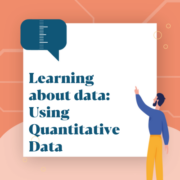Learning about data; What is quantitative data?
What is Quantitative Data?
Quantitative data is data that can be counted or measured in numerical values. As with qualitative data, there’s a good chance that you already have some collected for your organisation.
You might have collected some of the following:
- Sign-in sheets
- Feedback forms
- Surveys
- Polls
- Social media statistics
- Reports
We often find clients already have quite a bit of data they didn’t know they had collected!
The differences between primary and secondary quantitative data.
There is a distinction between primary and secondary quantitative data. Primary data is the data that your organisation has collected directly, such as footfall counts or feedback forms. Secondary data is data someone else has collected, for example a national age profile, or a partner shares their footfall data. It can helpful for you to draw comparisons between your collected data and national averages to see how your organisation compares.
Overcoming the challenges of working with quantitative data
There are some challenges to working with quantitative data. Often the biggest challenge is that it’s not collected in a format that makes it easy to compare to other collected data, or to secondary sources. The best solution for this is to plan in advance and use standardised questions at every opportunity to collect data. The answer format is also important so choosing a standard answer format will make it easier to compare data.
Tracking codes can be useful in identifying if you know the same person will be answering a survey multiple times so you can monitor their progress. A tracking code can be created within a survey using data such as: a combination of a person’s date of birth and their initials.
It’s always important to date the data particularly for paper copies of surveys which makes identifying the event possible and the data relatable to that event. If one of your feedback forms reveals a problem with the venue or experience, you need to know the date on which that particular event happened to make sure you can address the problem. Don’t forget, feedback forms may be input or analysed as a batch of forms after a few months of collection so it may prove difficult to find out which venue the problem occurred at if you don’t have a way to check.
Managing personal data from surveys
GDPR (General Data Protection Regulation) are regulations which relate to how we retain and use personal data. Within these regulations it is important to:

It’s important to maintain confidentiality and anonymity with personal information. Recording date of birth and full name poses a risk to personal identity, however, recording only a date of birth is not identifiable. There are also additional regulations regarding collection data from under 16-year-olds. It is possible to collect identifiable information, but if you do so you need to ensure that the data is obtained with consent, is properly secured and then destroyed once no longer needed.
Thinking about when to collect data
Recording information in the moment is valuable so it can help to set up processes to ensure you don’t miss out! One tactic that works is to have a standard question you ask at the end of every event. This, and the size of audience questioned can be collected for contextual purposes to see if the responses were representative of the larger audience.
Top tip – you don’t need to collect data from everyone!
Deciding how much data to collect
It’s important to consider whether sample sizes are large enough to provide you with sufficient data to base a decision on. 10% to 20% of the audience is usually a reliable sample size to base a decision on. If you hold many smaller events, it would be advisable to collect evidence from each event and consider it accumulatively to make decisions.







